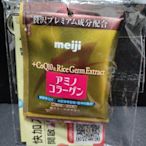搜尋結果
 $6475【Meiji 明治】膠原蛋白粉璀璨金28日份袋裝(196gx5袋)購物中心折價券
$6475【Meiji 明治】膠原蛋白粉璀璨金28日份袋裝(196gx5袋)購物中心折價券 $2590【Meiji 明治】膠原蛋白粉璀璨金28日份袋裝(196gx2袋)購物中心
$2590【Meiji 明治】膠原蛋白粉璀璨金28日份袋裝(196gx2袋)購物中心 $750明治膠原蛋白 悠遊卡Y5680145521
$750明治膠原蛋白 悠遊卡Y5680145521 $620明治膠原蛋白 悠遊卡 無背板Y7185716447
$620明治膠原蛋白 悠遊卡 無背板Y7185716447![現貨- 明治膠原蛋白粉 奢華黃金版 Meiji 補充包28日份 膠原蛋白 2024.08後 現貨- 明治膠原蛋白粉 奢華黃金版 Meiji 補充包28日份 膠原蛋白 2024.08後]() $830現貨- 明治膠原蛋白粉 奢華黃金版 Meiji 補充包28日份 膠原蛋白 2024.08後哇寶箱
$830現貨- 明治膠原蛋白粉 奢華黃金版 Meiji 補充包28日份 膠原蛋白 2024.08後哇寶箱![@跑腿@ 明治膠原蛋白粉 奢華黃金版 Meiji 補充包28日份 膠原蛋白 現貨~章魚哥小店 @跑腿@ 明治膠原蛋白粉 奢華黃金版 Meiji 補充包28日份 膠原蛋白 現貨~章魚哥小店]() $615@跑腿@ 明治膠原蛋白粉 奢華黃金版 Meiji 補充包28日份 膠原蛋白 現貨~章魚哥小店章魚哥小店
$615@跑腿@ 明治膠原蛋白粉 奢華黃金版 Meiji 補充包28日份 膠原蛋白 現貨~章魚哥小店章魚哥小店![Meiji 明治膠原蛋白粉 補充包28日份 日本原裝正品 膠原蛋白 !!新舊包裝轉換中!! Meiji 明治膠原蛋白粉 補充包28日份 日本原裝正品 膠原蛋白 !!新舊包裝轉換中!!]() $529Meiji 明治膠原蛋白粉 補充包28日份 日本原裝正品 膠原蛋白 !!新舊包裝轉換中!!JP日本專業代購
$529Meiji 明治膠原蛋白粉 補充包28日份 日本原裝正品 膠原蛋白 !!新舊包裝轉換中!!JP日本專業代購![日本明治 膠原蛋白粉 標準款 補充包 196g 28日份 期限:2025.05 日本明治 膠原蛋白粉 標準款 補充包 196g 28日份 期限:2025.05]() $490日本明治 膠原蛋白粉 標準款 補充包 196g 28日份 期限:2025.05二本家
$490日本明治 膠原蛋白粉 標準款 補充包 196g 28日份 期限:2025.05二本家![+東瀛go+Meiji 明治 膠原蛋白粉 28日份 標準版/加強版/含鈣版 196g 袋裝補充包 日本原裝 日本必買 +東瀛go+Meiji 明治 膠原蛋白粉 28日份 標準版/加強版/含鈣版 196g 袋裝補充包 日本原裝 日本必買]() $699+東瀛go+Meiji 明治 膠原蛋白粉 28日份 標準版/加強版/含鈣版 196g 袋裝補充包 日本原裝 日本必買+東瀛go+799超取免運全店現貨
$699+東瀛go+Meiji 明治 膠原蛋白粉 28日份 標準版/加強版/含鈣版 196g 袋裝補充包 日本原裝 日本必買+東瀛go+799超取免運全店現貨![美品專營店 買3送1 日本 Meiji 明治 膠原蛋白粉補充包28日份 現貨 美品專營店 買3送1 日本 Meiji 明治 膠原蛋白粉補充包28日份 現貨]() $373美品專營店 買3送1 日本 Meiji 明治 膠原蛋白粉補充包28日份 現貨美品專營店
$373美品專營店 買3送1 日本 Meiji 明治 膠原蛋白粉補充包28日份 現貨美品專營店![明治 膠原蛋白粉 標準版28日份 + 3日份增量包 217克 X 3入組 明治 膠原蛋白粉 標準版28日份 + 3日份增量包 217克 X 3入組]() $1650明治 膠原蛋白粉 標準版28日份 + 3日份增量包 217克 X 3入組Y6523721808
$1650明治 膠原蛋白粉 標準版28日份 + 3日份增量包 217克 X 3入組Y6523721808![美兒小舖COSTCO好市多代購~MEIJI 明治 膠原蛋白粉標準版(217gx3袋)附量匙 美兒小舖COSTCO好市多代購~MEIJI 明治 膠原蛋白粉標準版(217gx3袋)附量匙]() $1900美兒小舖COSTCO好市多代購~MEIJI 明治 膠原蛋白粉標準版(217gx3袋)附量匙下標前~請先詢問有無現貨
$1900美兒小舖COSTCO好市多代購~MEIJI 明治 膠原蛋白粉標準版(217gx3袋)附量匙下標前~請先詢問有無現貨
A representation of the 3D structure of the protein myoglobin showing turquoise α-helices. This protein was the first to have its structure solved by X-ray crystallography. Toward the right-center among the coils, a prosthetic group called a heme group (shown in gray) with a bound oxygen molecule (red). Proteins are large biomolecules and ...
Meiji Co., Ltd. (株式会社明治, Kabushiki-gaisha Meiji), formerly Meiji Dairies Corporation (明治乳業株式会社, Meiji Nyūgyō Kabushiki-gaisha), is a Japanese food company. It was a major dairy industry company established in 1917. Apart from dairy products like milk, ice cream, and cheese, their lineup includes sports drinks ...
Infobox references. Polyethylene glycol ( PEG; / ˌpɒliˈɛθəlˌiːn ˈɡlaɪˌkɒl, - ˈɛθɪl -, - ˌkɔːl /) is a polyether compound derived from petroleum with many applications, from industrial manufacturing to medicine. PEG is also known as polyethylene oxide ( PEO) or polyoxyethylene ( POE ), depending on its molecular weight.
Structure of a typical L-alpha-amino acid in the "neutral" form Amino acids are organic compounds that contain both amino and carboxylic acid functional groups.[1] Although over 500 amino acids exist in nature, by far the most important are the 22 α-amino acids incorporated into proteins.[2] Only these 22 appear in the genetic code of life.[3 ...
Vitamin B12, also known as cobalamin, is a water-soluble vitamin involved in metabolism.[2] It is one of eight B vitamins. It is required by animals, which use it as a cofactor in DNA synthesis, and in both fatty acid and amino acid metabolism.[3] It is important in the normal functioning of the nervous system via its role in the synthesis of ...
Escherichia coli (/ ˌ ɛ ʃ ə ˈ r ɪ k i ə ˈ k oʊ l aɪ / ESH-ə-RIK-ee-ə KOH-ly) is a gram-negative, facultative anaerobic, rod-shaped, coliform bacterium of the genus Escherichia that is commonly found in the lower intestine of warm-blooded organisms. Most E. coli strains are harmless, but some serotypes such as EPEC, and ETEC are pathogenic and can cause serious food poisoning in ...
Protein efficiency ratio. Protein efficiency ratio (PER) is based on the weight gain of a test subject divided by its intake of a particular food protein during the test period. From 1919 until very recently [when?], the PER had been a widely used method for evaluating the quality of protein in food.








